Family : Mullidae

Text © Giuseppe Mazza

English translation by Mario Beltramini
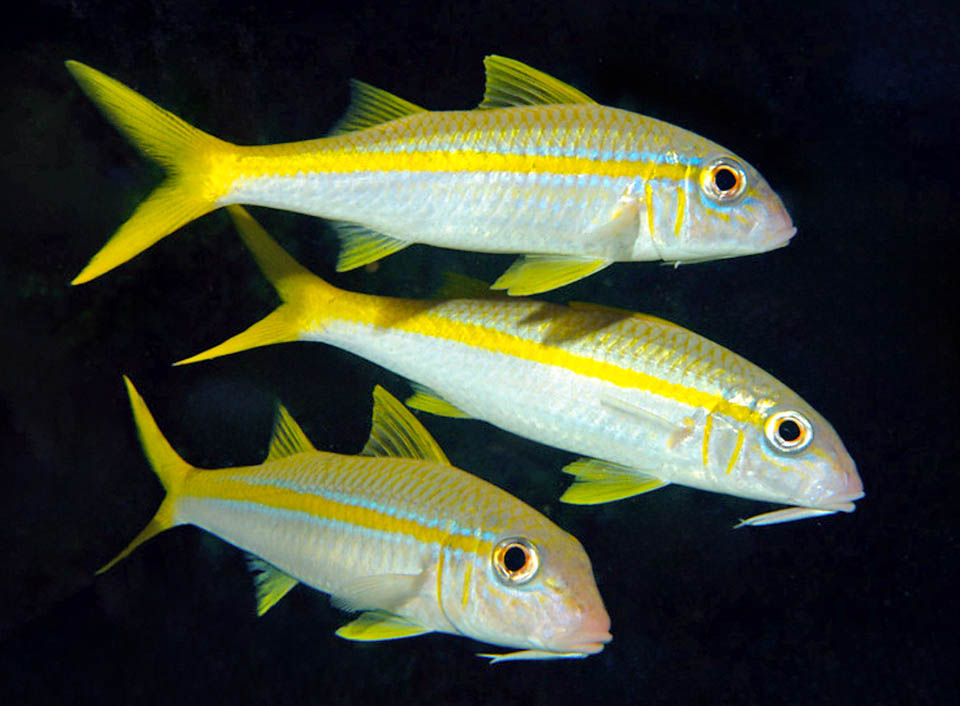
Mulloidichthys martinicus is a tropical Atlantic mullet characterized by a longitudinal yellow band © Pauline Walsh Jacobson
Mulloidichthys martinicus (Cuvier, 1829) belongs to the class of the Actinopterygii, the ray-finned fishes, to the order of the Mulliformes and to the family of the Mullidae, that of the mullets, that counts 6 genera and about one hundred species.
At first glance it reminds the analogous Striped red mullet (Mullus surmuletus), frequent in the Mediterranean, the Black Sea and along the eastern Atlantic coasts from England to Mauritania, in fact the term Mulloidichthys originates in Greek from the genus Mulloides, that is shaped like a Mullus, and “ichthys”, fish. Therefore, a circumlocution to say that it is a fish similar to a mullet.
Conversely, the name of the species, martinicus, of Martinica in Latin, reminds its presence along the coasts of this well-known French island of the West Indies.
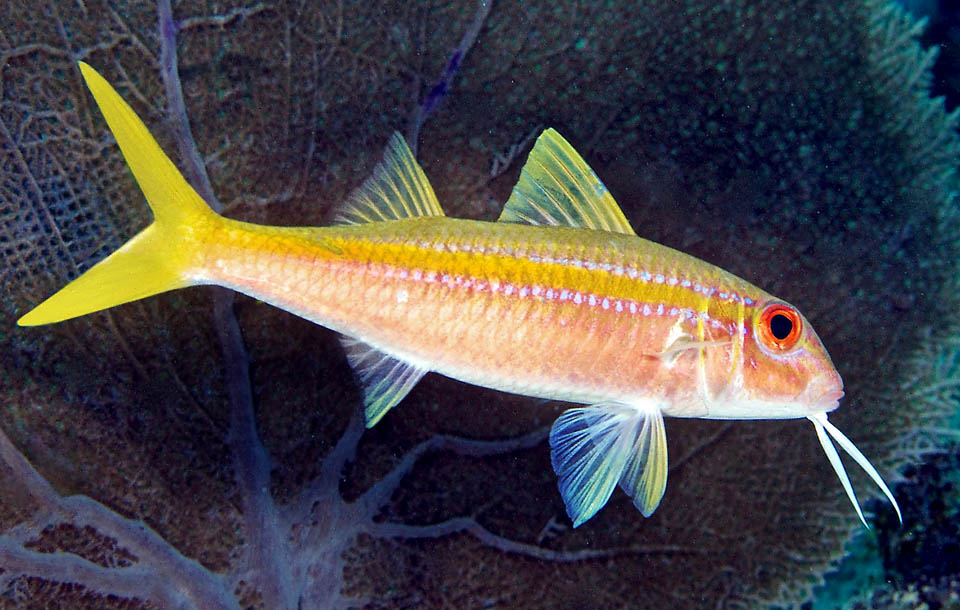
Averagely 28 cm long has two dorsal fins and showy barbels: very sensitive chemosensory organs to skim the seabeds looking for many benthic invertebrates © Allison & Carlos Estape
Zoogeography
Actually the distribution range of Mulloidichthys martinicus extends, in addition to the Caribbean, to various tropical locations of the Atlantic. In America, we find it from the Bahamas, Florida and the Gulf of Mexico up to southern Brazil, and then, in the middle of the ocean, at the archipelago of Trindade and Martim Vaz, the islands of Ascension and Saint Helena, and reaches, not far from the African coasts, the Canary islands, Cape Verde and São Tomé in the Gulf of Guinea.
Ecology-Habitat
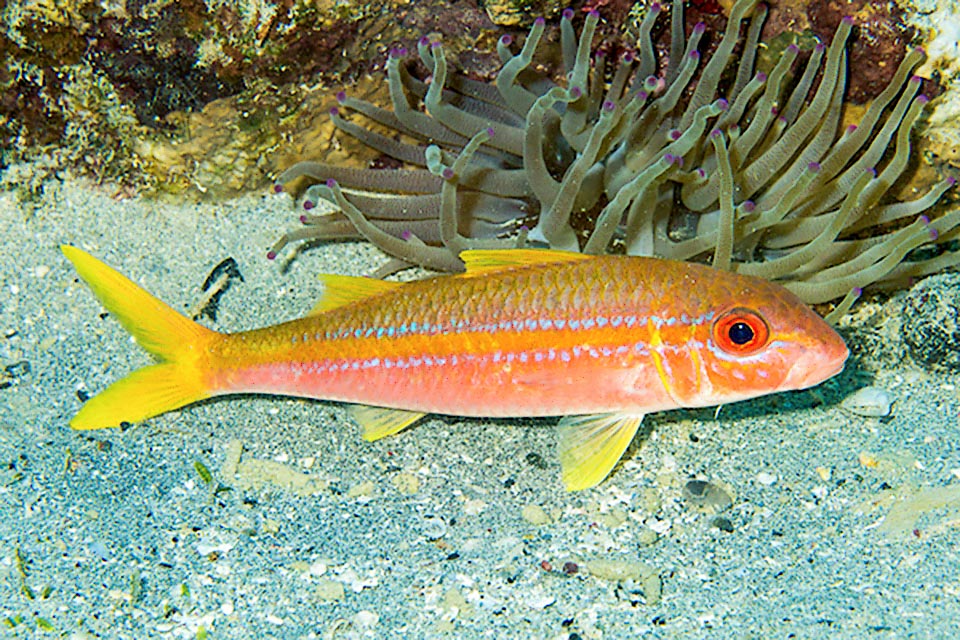
The livery is quite variable depending on mimetic needs and the emotions, and here the dominant tone is decidedly red © Allison & Carlos Estape
Mulloidichthys martinicus goes swimming mainly in shallow waters, in the first 35 m of water, but also up to about 50 m of depth with a maximum of 135 m.
Usually the adults frequent the sandy and gravelly zones near the madreporic formations and the stretches of brown seaweeds whilst the juveniles grow up in the submerged prairies of phanerogams.
It is not present in the regions having no coral reefs and at the mouth of the rivers.
Morphophysiology
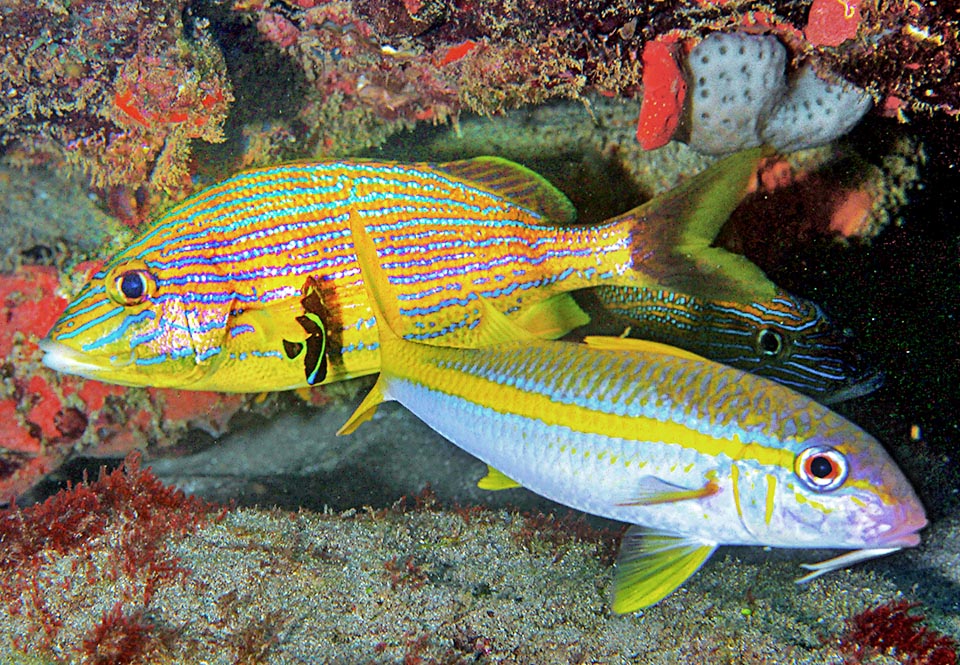
To demonstrate the incredible speed with which the colours of this mullet change due to the chromatophores, we compare these two pictures, taken just a moment apart in the cleaning station kept by a young Pomacanthus paru, the small French angelfish at the centre of photo who grows freeing the passing-by fishes from the skin parasites © Kevin Bryant
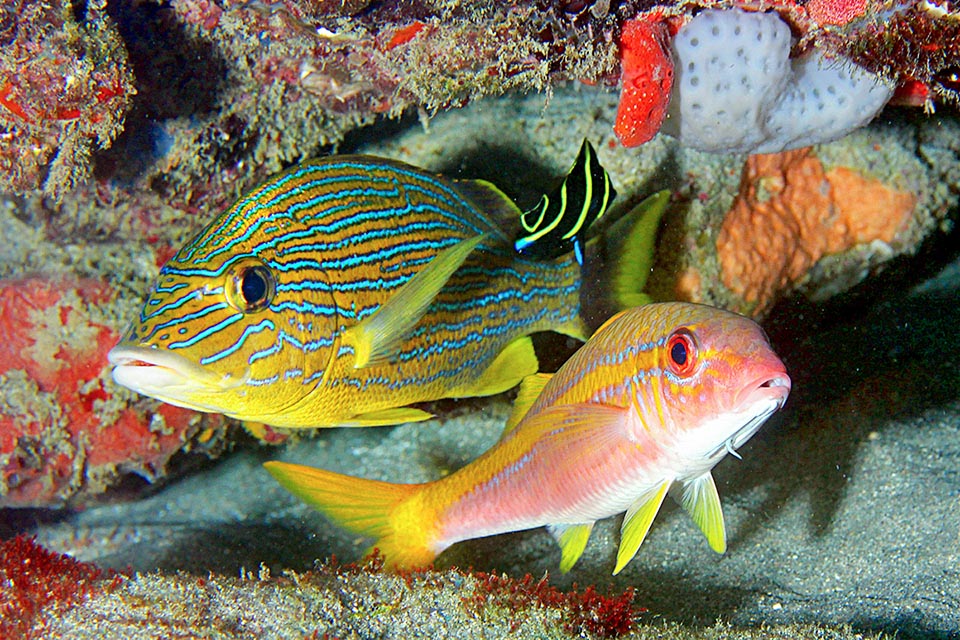
A moment later, always with Haemulon sciurus in the clinic with showy and characteristic sponges as sign, the mullet with yellow band and bluish shades has become red © Kevin Bryant
Mulloidichthys martinicus may reach a length of 45 cm, but the current size is about 28 cm.
The body is elongated, cylindrical,almost flat like the head on the ventral side. The head is relatively big, with the forehead steep and convex, and we note a short spine on the operculum. The mouth, sited below, protractile, with tiny conical and villiform teeth, has a short jaw that does not reach the fore part of the eye.
The two long and fleshy barbels, under the chin, contain very sensitive chemosensory organs that lead the fish when it probes the sand and the ravines looking for benthic invertebrates.
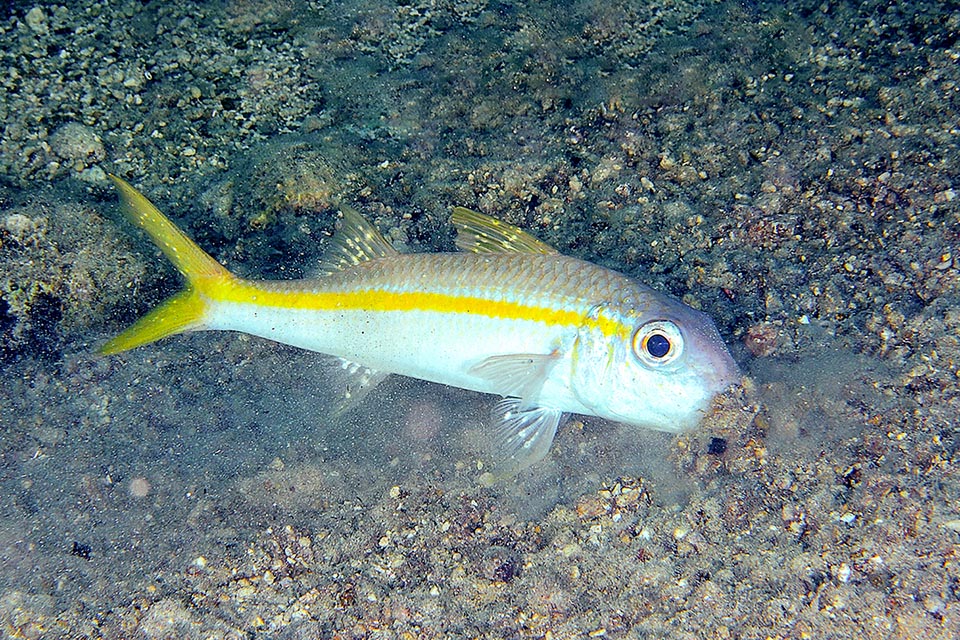
Mulloidichthys martinicus working, while led by the barbels ploughs the seabed looking for polychaetes, bivalve molluscs and small crustaceans © Kevin Bryant
There are two dorsal fins: the first with 8 spiny rays and the second with 1 spiny ray and 8 soft ones. The anal fin has 2 spiny rays and 6 unarmed. The pectoral ones have 16 soft. The caudal is forked.
The livery, light olive above and whitish below, is changeable according to the circumstances due to the effect of the chromatophores, but especially has a characteristic yellow stripe, almost always emphasized by a blue border that goes from the eye to the caudal peduncle.
This yellow stripe, unique in the world of mullets, is an important element for the fast visual identification of the fish, also when in its whole it tends to red. In any case the fins remain always yellow or yellowish.
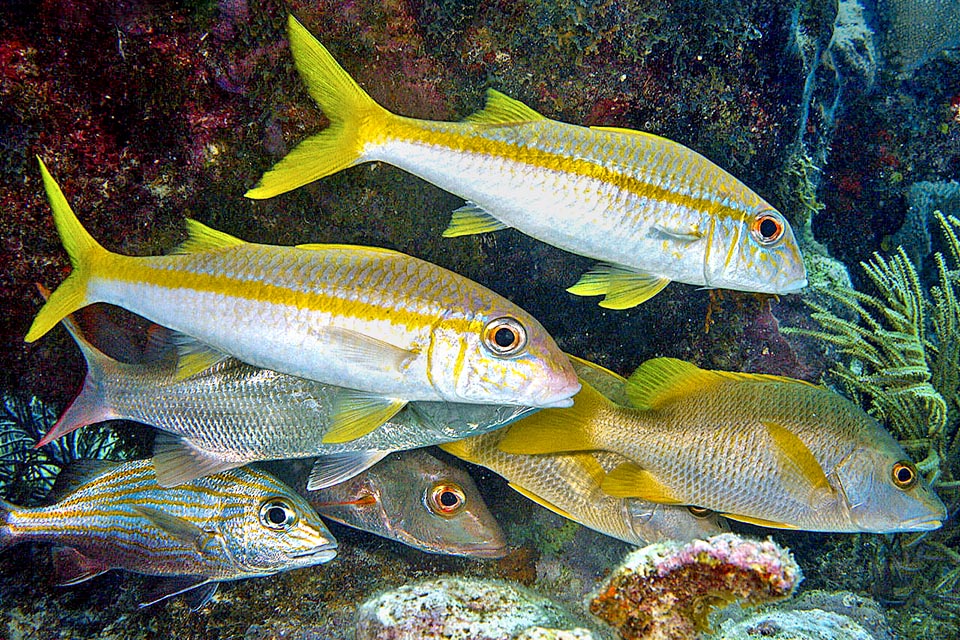
Often it associates to schools of Haemulidae and Lutjanidae to get unobserved to eyes of predators with some of more chances of survival in case of attacks, but when hunts alone, some fishes like Caranx ruber survey it closely, take advantage from its ability in finding out with barbels the preys to steal him, quickly, the food from its mouth © Kevin Bryant
Ethology-Reproductive Biology
Mulloidichthys martinicus feeds mostly on benthic invertebrates, usually polychetes, bivalve molluscs such as the clams and small crustaceans, but also of small fishes, often hunted in school during the day.
It is easy to find it mixed with the gatherings of Haemulidae, like Haemulon chrysargyreum, or of Lutjanidae, such as Ocyurus chrysurus, that it perfectly imitates in the livery and the profile folding the barbels on the throat into the dedicated central groove. In fact, camouflaged in the large schools, it escapes the gaze of the predators, has a better chance of surviving in case of attacks.
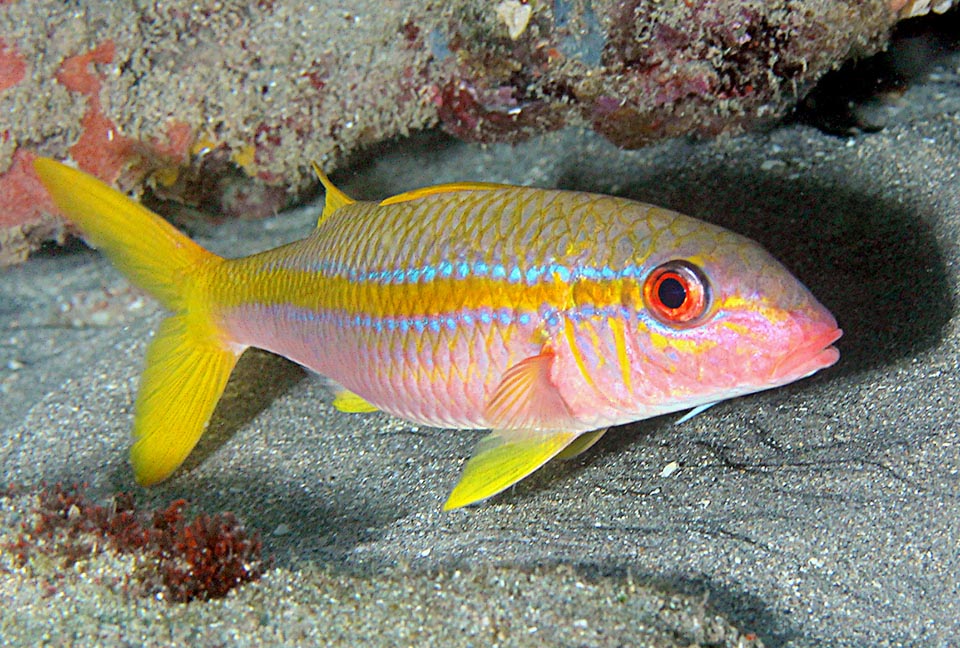
The reproduction of Mulloidichthys martinicus occurs twice a year, in spring and in autumn, and the pelagic eggs are entrusted to the currents © Kevin Bryant
Conversely, when it ploughs the seabeds solitary with its barbels, it is often sided, in spite of itself, by fishes like Caranx ruber who take advantage of its ability in finding the prey to quickly steal the food from its mouth.
The males reach sexual maturity when about 18,5 cm long and are bger and numerous than the females, who, on the other hand, are already ready to spawn when about 17,5 cm long.
The reproduction, with pelagic eggs entrusted to the currents, occurs twice a year, mainly from March to April and then from September to October. The juveniles grow together moving in dense schools and this habit is maintained also in the formations of the adults who, when resting or hunting in groups among the corals, have all the same size.
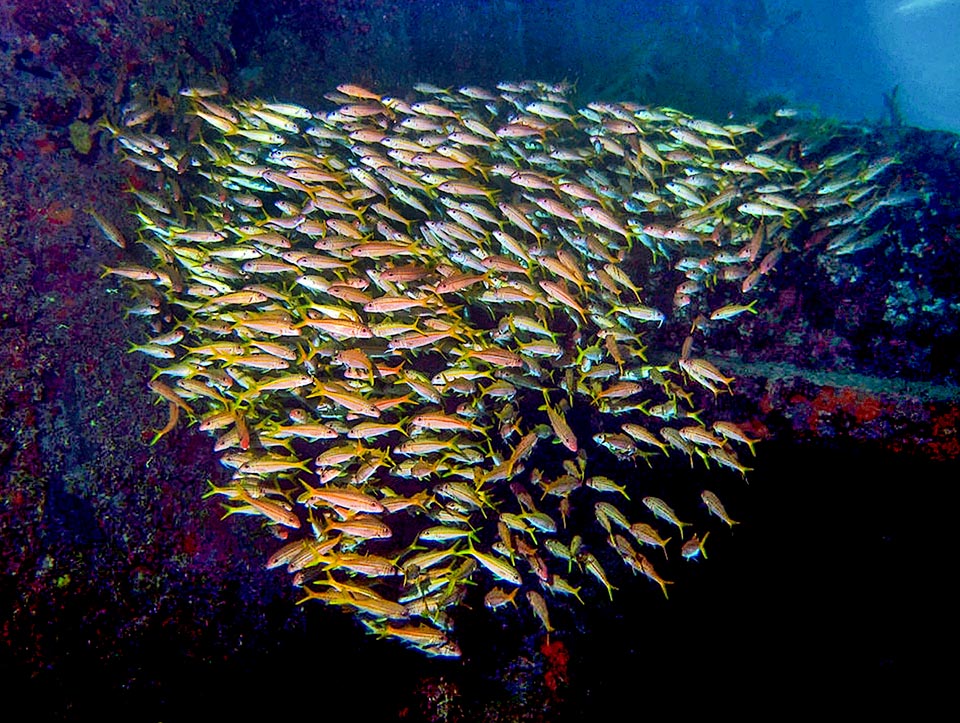
The juveniles grow together forming often huge schools of peers. A habit they keep even when adult while moving or hunting during the day © Pauline Walsh Jacobson
In the wild the main foes of Mulloidichthys martinicus are the Common dolphinfish (Coryphaena hippurus), the Little tunny (Euthynnus alletteratus) and groupers like Epinephelus guttatus.
Thanks to the fact that it is continuously moving it is not, on the other hand, threatened by the invasive Pterois volitans incautiously introduced in the Caribbean.
The flesh of this mullet is excellent and is often fished with the fishing lines, traps and gillnets if at times is at risk of ciguatera, a severe food poisoning theoretically possible if they have been preying upon animals who store in their tissues the toxin produced by the dinoflagellate Gambierdiscus toxicus.
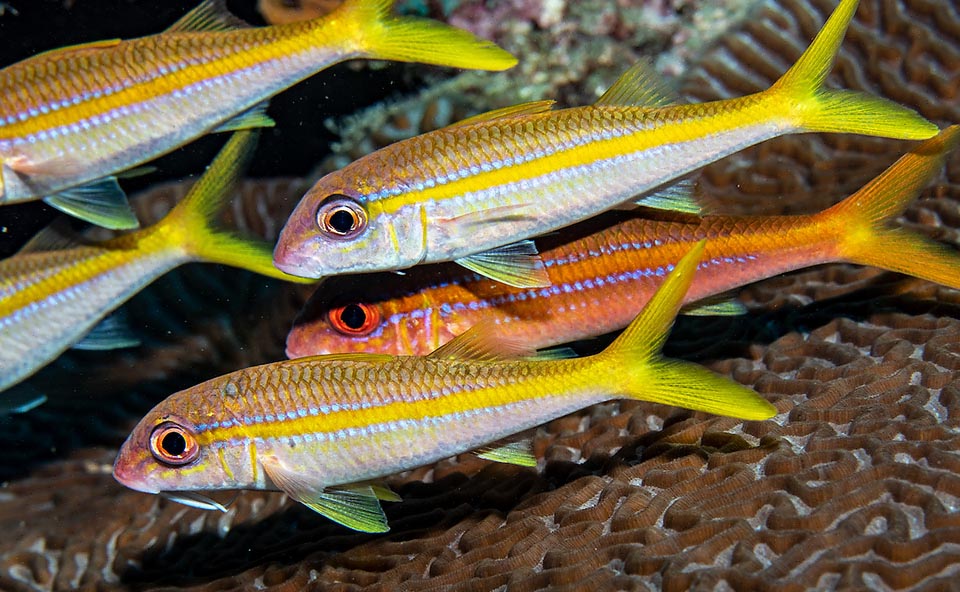
The flesh of Mulloidichthys martinicus is excellent, but fishing is moderate and these juveniles have good chances to get adult © Allison & Carlos Estape
However, the fishing pressure keeps low if referred to other species and the populations are stable. The resilience is mediocre, with a minimum time for the doubling of the populations of 1,4-4,4 years, but the fishing vulnerability marks only 35 on a scale of 100.
Consequently, Mulloidichthys martinicus appears from 2013 as “LC, Least Concern”, in the IUCN Red List of the endangered species.
Synonyms
Upeneus martinicus Cuvier, 1829; Mulloides martinicus (Cuvier, 1829).
→ For general information about FISH please click here.
→ For general information about BONY FISH please click here
→ For general information about CARTILAGINOUS FISH please click here.
→ To appreciate the BIODIVERSITY of BONY FISH please click here.
→ To appreciate the BIODIVERSITY of CARTILAGINOUS FISH please click here.
